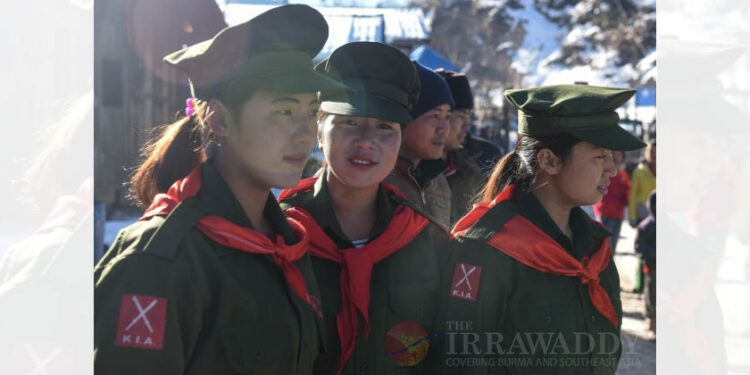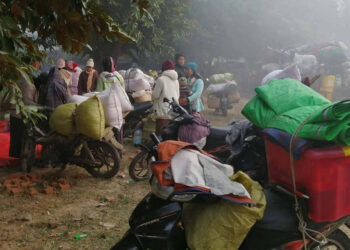War and Peace in the Borderlands of Myanmar: The Kachin Ceasefire, 1994-2011, edited by Mandy Sadan, NIAS Press, Copenhagen. 2016. 540 pages.
To say that the edited collection War and Peace in the Borderlands of Myanmar arrives at a critical time in Myanmar’s political history is perhaps an understatement. While Myanmar continues along its path of political and economic change, the country’s pursuit of peace in its borderlands has stagnated.
Despite its status as a key concern for the democratically-elected National League for Democracy (NLD), Myanmar’s peace process has stalled in its longest deadlock since its inception in August 2011, as Liu Yun noted recently. To this— a seemingly intractable state of affairs— the authors included in this edited collection bring new perspectives, drawing on the history of the Kachin and their neighbors as a means of identifying lessons learned and possible ways forward.
Given that the Kachin ceasefire, signed in 1994, was one of the longest-held peace agreements in Myanmar’s recent history, understanding how it was sustained for over 17 years is certainly a valuable aim in itself.
Yet, as the editor of this book, Mandy Sadan, so eloquently argues in her introduction to the collection, perhaps the question that most urgently demands scholarly attention is why, contrary to expectations, the Kachin ceasefire would breakdown in 2011, at precisely the point when an upswing in Myanmar’s national mood made nationwide peace seem achievable.
As Sadan suggests, if “ceasefire” remains the key buzz word for Myanmar’s ethnic conflicts, then it is crucial that we ask why Kachin civilians felt that the situation created by 17 years of armed peace was no longer worth supporting.
To answer this question, the authors featured in this collection propose that we must be willing to rethink a number of dichotomies upon which narrow interpretations of Myanmar’s ethnic conflicts often depend.
The first, as the book’s title might lead its readers to predict, is the sharply defined separation between war and peace. A framework that understands war and peace as diametrically opposed impels us to see the breakdown of the Kachin ceasefire as “an anomaly,” with the Kachin seen as “spoiling the party for everyone else,” as Sadan puts it.
Contrary to this, the authors of this collection propose that we might take a longer view of Myanmar’s borderlands and consider how war and peace, conflict and ceasefire, jointly produce certain historical forms of political opportunity and struggle.
Cycles of conflict must not be considered in isolation, but instead demand the sort of analysis modeled in Chapter Two by Robert Anderson and Sadan, who propose a new periodization of the Kachin conflict that explicitly links Kachin history as far back as the post-World War period to the present moment.
Defining the post-1994 peace in Kachin State as the “second Kachin ceasefire,” Anderson and Sadan adopt a locally-articulated perspective on Kachin history that notes crucial resonances between the recent deterioration of peace and concerns reaching as far back as the pre-independence era.
The need for a more historically-oriented perspective is a point echoed in Martin Smith’s contribution, too; the six-decade narrative he writes underscores the depth of the mistrust and resentment felt by the Kachin people when it comes to Myanmar’s political system, as well as the extent of the political challenges faced by peace negotiators.
While some of the most fascinating aspects of these discussions relate specifically to the Kachin case — for example, Sadan’s discussions of traditional Kachin means of marking historical transformations (also explored later by Ho Ts’ui-p’ing) — the broader relevance is clear: the importance of considering the interplay between war and peace, via a longer historical view, does not hold only for the Kachin, but might perhaps be transformative for Myanmar’s peace process at-large.
The second established dichotomy the authors of this edited collection seek to question is that which works to define the actors in Myanmar’s ethnic conflicts; too often, observers and scholars alike take a simplistic view of both the Tatmadaw and its adversaries, assuming both entities are bounded and internally homogenous. What the authors of this collection make readily apparent is that this is rarely the case.
First off, as Kevin Woods argues, actors that might exist in opposition to one another may not be so discrete in times of peace. Pursuits related to logging and agri-business, as a part of a broader form of “ceasefire capitalism” described by Woods, result in a situation more aptly described as a “multi-layered mosaic,” than “separable territorial entities that may be categorized as ‘government’ or ‘rebel.’”
Moreover, even when actors are identifiable as discrete entities, they may not be as internally uniform or consistent as we might expect. While Lee Jones’ contribution makes a broader argument related to the political-economy of state-building, a particularly interesting portion of his chapter describes how the actions of the Tatmadaw and wider Thein Sein administration cannot be understood as merely replicating previous regimes’ approaches to peace; while some aspects of recent peace negotiations were conventional and implied some continuity, others were unprecedented, such as their departure from a historical “divide and rule” strategy and willingness to pursue a national ceasefire agreement with the involvement of international parties.
Yet, it is not only our image of the Myanmar state that must be disrupted, but our vision of the Kachin, as well. As Jenny Hedström makes abundantly clear in her contribution, the Kachin cannot be considered a unitary bloc, nor can Kachin combatants; the active role of women combatants, in particular, demands a rethinking of the gendered dimensions of the dominant discourse around war and peace— a discourse that is often male-dominated and closed to outsiders. More broadly, the close reading of Kachin nationalist discourses provided by Laur Kiik, and the analyses of the circulation and distribution of nationalist materials offered by Helen Mears and Hkanhpa Tu Sadan, demonstrate the ways in which Kachin histories— and the political or nationalist discourses they inspire— are diverse, contradictory, and exceedingly complex.
As Kiik notes, Kachin popular theories of nationhood cannot easily be reduced to a single grievance, such as “resource nationalism;” Kachin nationalism, he and others propose, cannot be understood as one stable, static logic. This resonates with what Sadan says in her introduction: that a careful examination of nationalist discourse often reveals more rupture than it does continuity; Kiik notes the diversity of opinions existent amongst Kachin/non-Kachin and ‘sub ethnic’ groups living in Kachin State, while Jenny Hedström reveals the complexity of reflections on the active role of women combatants, across both divisions of gender and of generation.
When we broaden the scope of our enquiries to take account of Myanmar’s neighbors, the necessity to complicate assumptions around the exceptionality and bounded-ness of “the Kachin” becomes even more apparent.
Ho Ts’ui-p’ing’s contribution on relationships between the Jingpo of Yunnan and the Kachin in Myanmar and Mears’ on the cross-border circulation of graphic calendars make clear that the effects of conflict do not stop at national borders, but rather reverberate through cross-border manau festivals, social and economic networks, and political negotiations.
Thus the issue of the Kachin ceasefire, as Enze Han makes clear in Chapter Six, has impacts that reach outside Myanmar, to China and beyond, with what might have previously been considered local grievances— such as, for example, the debate over the Myitsone Dam— demonstrating “the changing international dynamics within which conflict and peace in this region are situated.”
Reshmi Banerjee’s reflections on conflict around land ownership in North East India speaks to these changing international dynamics, but in asking how they might be intimately connected with a lower strata of resource-oriented conflicts, she underscores the need to take seriously concerns around access to land, as they relate to the Kachin case. A second study from India, described in the chapter by Joy L. K. Pachuau and Mandy Sadan, also provides significant lessons, highlighting the need to consider forms of social memory and its construction, insofar as contestations around how conflict might be remembered— or whether it is actively remembered at all— intersects explicitly with how peace might be envisioned.
Chapters by Patrick Meehan and Mikael Gravers offer additional comparative studies, assessing the Kachin conflict in relation to those in Northern Shan State and Karen State, respectively. Their two contributions make it clear that scholars may not need to look beyond Myanmar’s borders for insight into the conflict within which the Kachin are currently entrenched; Meehan, for example, notes that while the Palaung have signed a ceasefire agreement the “messy, volatile, and constantly shifting situation” in Northern Shan renders hopes for a more durable system of rule untenable, whereas Gravers notes that longstanding tendencies toward internal fragmentation amongst the Karen might ultimately work to the advantage of the Tatmadaw.
Both cases of conflict, as negotiated by the Palaung and by the Karen, they argue, flag significant challenges to peace that must be considered alongside the more widely discussed issues such as trust-building and political dialogue.
Finally, by interweaving personal narrative, locally-salient reflections, and academic analyses, this edited volume mediates the last and perhaps most damaging dichotomy it identifies within approaches to war and peace in Myanmar: that which divides the “scholarly” and “lived,” the political from the personal, and academic debate from actually-circulating discourse.
Contributions by Nhkum Bu Lu, Duwa Mahkaw Hkun Sa and Hkanhpa Tu Sadan intervene crucially into the book’s longer arc, providing personal narratives that ground the analyses that precede and follow their accounts. These contributions produce more than just an inclusive and polyphonic text, though, offering up key insights that sometimes support, sometimes contradict, but always enrich our reading of the entire volume.
As Matthew Walton acknowledges in his concluding section, the collaboration modeled here remains rare not only in the academy, but is also “virtually unheard of in Myanmar” given that groups representing different ethnic interests rarely see opportunities to productively engage with one another.
Whether they be the Western-generated concepts that undergird the scholarly literature, the Burman perspective that dominates public discourse in Myanmar, or the broader set of static dichotomies I’ve sought to highlight here, this book makes substantial strides in encouraging a rethinking of received knowledge about just how war and peace operate in Myanmar. At a time when Myanmar’s peace process has deadlocked, new approaches to making sense of war, and novel means of imagining peace, might be just what is most needed.
This article originally appeared in Tea Circle, a forum hosted at Oxford University for emerging research and perspectives on Burma/Myanmar.
Courtney T. Wittekind is currently a PhD student in Social Anthropology at Harvard University. She completed a M.Phil at the University of Oxford where she studied as a member of St Antony’s College and Rhodes Scholar. Her current research centers on questions of political transition, geography, and the unseen in Myanmar’s Shan State.

















